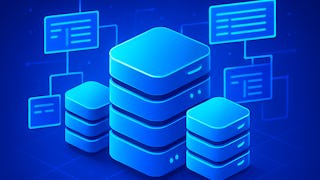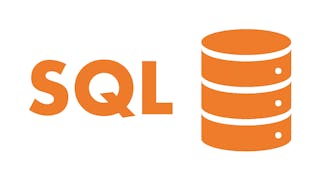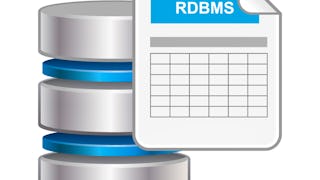In today's data-driven world, the ability to work with relational databases is an essential skill for professionals in various fields. This course is designed to equip you with the knowledge and practical skills needed to become proficient in database management and application development. Whether you are pursuing a career as a database administrator, software developer, or data analyst, this course provides you with a strong foundation to excel in your chosen field.

Enjoy unlimited growth with a year of Coursera Plus for $199 (regularly $399). Save now.

Relational Database Implementation and Applications
This course is part of multiple programs.


Instructors: Gerald Balekaki
1,736 already enrolled
Included with
(29 reviews)
Recommended experience
What you'll learn
Implement relational database and usage of indexes, views, triggers, temporary tables, functions, and stored procedures.
Develop database-driven applications using programming languages, such as Java, Python or C/C++ and frameworks.
Describe transaction and concurrency control concepts in relational databases.
Skills you'll gain
Details to know

Add to your LinkedIn profile
13 assignments
See how employees at top companies are mastering in-demand skills

Build your subject-matter expertise
- Learn new concepts from industry experts
- Gain a foundational understanding of a subject or tool
- Develop job-relevant skills with hands-on projects
- Earn a shareable career certificate

There are 7 modules in this course
Welcome to Relational Database Implementation and Applications! In Module 1 of this course, you'll delve into the fundamental aspects of building relational databases. You'll learn about implementing indexes, views, triggers, functions, and stored procedures in relational databases. We'll highlight the significance of these elements in databases and how they enhance query performance. You'll explore the creation of both simple and complex views, understanding how they offer data abstraction benefits and the versatility of managing data through views. Additionally, you'll gain experience in creating and optimizing database operations using user-defined functions, triggers, and stored procedures in SQL, thus acquiring comprehensive knowledge of accurate business logic implementation and performance optimization techniques.
What's included
5 videos10 readings2 assignments1 discussion prompt1 ungraded lab
Module 2 of this course offers an immersive exploration of the powerful world of SQL window functions and OLAP (Online Analytical Processing) concepts. You will learn about the definition and benefits of window functions, gaining proficiency in advanced applications such as RANK(), DENSE_RANK(), LEAD(), LAG(), NTILE(n), PERCENT_RANK(), and CUME_DIST(). Additionally, you'll develop the skills to control window function behavior using PARTITION BY and ORDER BY clauses, define custom window frames with RANGE and ROWS clauses, and design, query, and analyze OLAP datasets using ROLL-UP and DRILL-DOWN levels of aggregation.
What's included
3 videos5 readings2 assignments1 ungraded lab
In Module 3 of this course, you'll learn how to develop database applications using versatile programming languages such as Java, Python, or C++. You'll discover how to establish connections to databases, perform essential CRUD (Create, Read, Update, Delete) operations, and write code that supports SQL features like triggers, functions, and stored procedures used to facilitate complex queries in relational databases. The focus will be on robust database interactions, including error and exception handling to address connection issues, query failures, and data validation, ensuring the reliability of your applications.
What's included
3 videos6 readings2 assignments1 ungraded lab
Module 4 of this course provides an in-depth understanding of indexing within database systems. You'll define indexing and grasp its critical importance. Through comprehensive exploration, you'll differentiate between various types of indexes, including ordered and hash indexes, primary and secondary indexes, as well as multi-level and single-level indexes. Additionally, you'll delve into the structure of B+-trees, including nodes and leaves, and learn how these structures maintain balance, supporting efficient search operations. You'll also gain insight into B+-tree insertion and deletion operations.
What's included
2 videos3 readings2 assignments1 ungraded lab
In Module 5, you will enter into the world of database transactions and their critical role in ensuring data consistency and integrity. You will gain a comprehensive understanding of the four ACID properties (Atomicity, Consistency, Isolation, Durability) and their significance in maintaining the reliability of transactions. Additionally, you'll explore techniques for managing concurrent access to data, including discussions on COMMIT and ROLLBACK behaviors, serial and serializable schedules, and conflict serializability tests using graph-based techniques. This module will also cover concepts like equivalent serial schedules, recoverability, and cascade-less schedules, empowering you to design and manage complex database systems with confidence and precision.
What's included
3 videos3 readings2 assignments1 ungraded lab
Module 6 focuses on concurrency control in database management systems. You'll define concurrency control and understand its significance in maintaining data integrity while delving into the principles of lock-based concurrency control. This module will cover key concepts such as shared and exclusive lock types, lock modes, lock compatibility, and introduce the two-phase locking protocol with its guarantees. Additionally, you'll gain insights into how transactions acquire and release locks within this protocol, and you'll explore the concept of deadlocks and their underlying causes, equipping you with essential knowledge to manage concurrent access effectively and prevent data integrity issues in database systems.
What's included
2 videos3 readings2 assignments1 ungraded lab
This module contains the summative course assessment that has been designed to evaluate your understanding of the course material and assess your ability to apply the knowledge you have acquired throughout the course.
What's included
1 assignment
Earn a career certificate
Add this credential to your LinkedIn profile, resume, or CV. Share it on social media and in your performance review.
Build toward a degree
This course is part of the following degree program(s) offered by Illinois Tech. If you are admitted and enroll, your completed coursework may count toward your degree learning and your progress can transfer with you.¹
Instructors


Offered by
Explore more from Data Analysis

Birla Institute of Technology & Science, Pilani
 Status: Preview
Status: PreviewUniversitat Politècnica de València
 Status: Free Trial
Status: Free TrialIllinois Tech
 Status: Free Trial
Status: Free Trial
Why people choose Coursera for their career




Learner reviews
29 reviews
- 5 stars
68.96%
- 4 stars
24.13%
- 3 stars
3.44%
- 2 stars
3.44%
- 1 star
0%
Showing 3 of 29
Reviewed on Oct 13, 2024
Very Challenging, but quite rewarding to see the outcome (when your project functions as hoped).

Open new doors with Coursera Plus
Unlimited access to 10,000+ world-class courses, hands-on projects, and job-ready certificate programs - all included in your subscription
Advance your career with an online degree
Earn a degree from world-class universities - 100% online
Join over 3,400 global companies that choose Coursera for Business
Upskill your employees to excel in the digital economy
Frequently asked questions
To access the course materials, assignments and to earn a Certificate, you will need to purchase the Certificate experience when you enroll in a course. You can try a Free Trial instead, or apply for Financial Aid. The course may offer 'Full Course, No Certificate' instead. This option lets you see all course materials, submit required assessments, and get a final grade. This also means that you will not be able to purchase a Certificate experience.
When you enroll in the course, you get access to all of the courses in the Specialization, and you earn a certificate when you complete the work. Your electronic Certificate will be added to your Accomplishments page - from there, you can print your Certificate or add it to your LinkedIn profile.
Yes. In select learning programs, you can apply for financial aid or a scholarship if you can’t afford the enrollment fee. If fin aid or scholarship is available for your learning program selection, you’ll find a link to apply on the description page.
More questions
Financial aid available,

